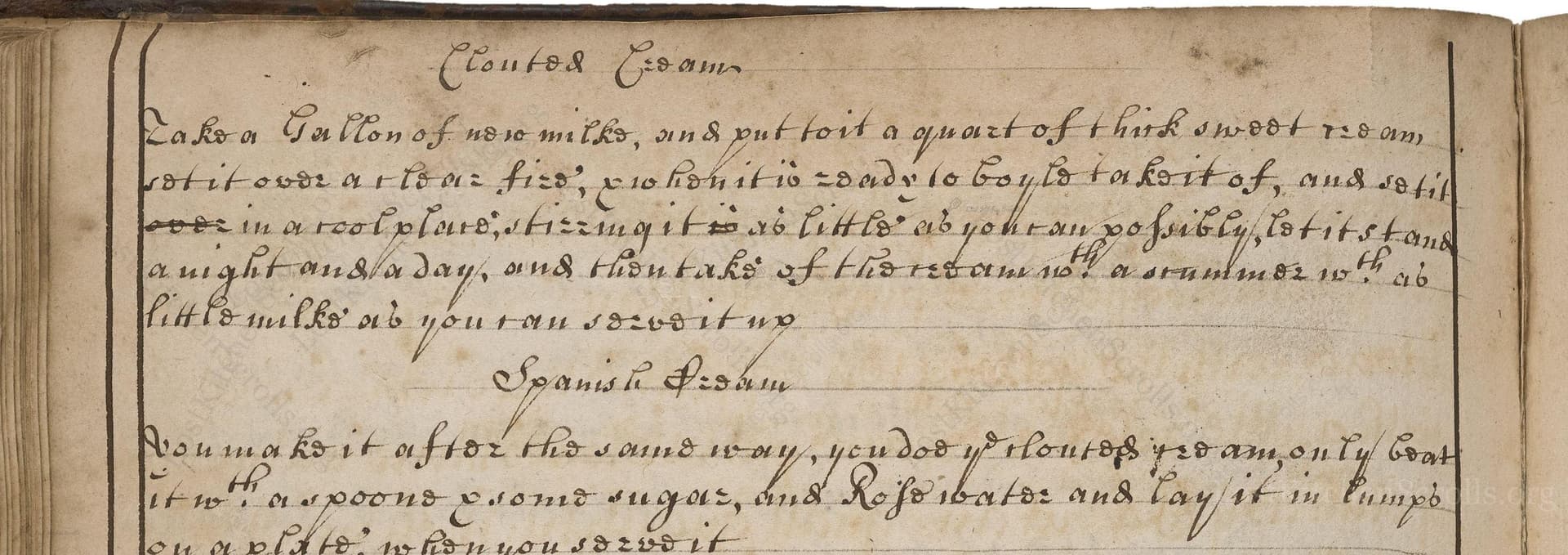
Clotted Cream
"Lake a Gallon of new milke, and put toit a quart of thick sweet ream, set it over a slow fire, when it is eady to boyle take it of, and set it in a cool place, stirring it a night and a day, and take as litle milke as you can see it up"
Note on the Original Text
This recipe is written in a condensed, almost telegraphic style common to early modern English manuscripts. Spelling is inconsistent: 'milke' for 'milk', 'ream' for 'cream', 'eady' for 'ready', and 'boyle' for 'boil.' Punctuation and exact measurements are vague, as these were often based on lived knowledge rather than fixed quantities, and the method relies on visual cues like 'when it is ready to boyle.' Recipes were often written as reminders rather than instructional texts, assuming a working knowledge of the steps by experienced kitchen staff.

Title
Cookery and medicinal recipes by Kendall Rose and Anne Cater (1712)
You can also click the book image above to peruse the original tome
Writer
Rose Kendall, Anne Cater, Elizabeth Clarke, Anna Maria Bold
Era
1712
Publisher
Unknown
Background
Step into the inviting kitchens of the past with this enchanting collection of culinary wisdom from England's early modern era. Crafted by a talented array of women, this book promises savory pies, sweet confections, and secret family recipes—an aromatic tour through centuries-old feasts sure to delight the curious palate.
Kindly made available by
Folger Shakespeare Library
This recipe appears in English household manuscripts between the late 17th and early 18th centuries, a period known for elaborate but resourceful dairy recipes. Clotted cream was a luxurious delight, associated with the rural west of England, especially Devon and Cornwall. It would grace the tables for breakfast, tea, or desserts, favored by the gentry and aspirational households alike. Our version traces its origins to a compilation by women active between 1675 and 1750, reflecting both the methods and ingredients available to well-to-do families on country estates who had access to fresh dairy straight from their own cows.

In the past, this recipe would require a large, shallow brass or copper pan (known as a 'scalding pan'), a gentle hearth or stove for slow heating, and a cool dairy larder or cellar to help the cream rise and set. Skimming implements, such as wide, flat spoons or wooden paddles, would be employed to lift the thickened cream after setting. Modern cooks can use a wide oven-proof dish or skillet, a stovetop or oven for gentle heating, a refrigerator for chilling, and a flat skimmer or spatula for removing the clotted cream.
Prep Time
10 mins
Cook Time
1 hr
Servings
12
We've done our best to adapt this historical recipe for modern kitchens, but some details may still need refinement. We warmly welcome feedback from fellow cooks and culinary historians — your insights support the entire community!
Ingredients
- 4 1/4 quarts fresh whole milk (preferably unhomogenized)
- 1 quart heavy cream (35% fat or higher, unpasteurized if possible)
Instructions
- Begin with 4¼ quarts (4.2 quarts) of fresh whole milk and add 1 quart of heavy cream (at least 35% fat) to it.
- Pour the mixture into a large, wide, shallow pan—preferably one that can go on the stove or oven.
- Slowly heat the milk and cream mixture over very low heat until it is just about to boil—around 185°F (85°C)—but do not allow it to bubble vigorously.
- Remove the pan from the heat and leave it undisturbed in a cool place for 12–24 hours to allow the clotted cream to form a thick, golden crust on the surface.
- Gently skim off the clotted cream, trying to take as little of the underlying milk as possible, and transfer it to a clean container.
- Briefly stir the clotted cream to an even consistency before serving.
- Chill before use.
Estimated Calories
360 per serving
Cooking Estimates
Preparing clotted cream takes a short time to combine the milk and cream and set up your pan. Most of the time is waiting for the mixture to gently heat and then for the cream to set overnight. Each serving contains about 360 calories, and you'll get 12 servings from this batch.
As noted above, we have made our best effort to translate and adapt this historical recipe for modern kitchens, taking into account ingredients nowadays, cooking techniques, measurements, and so on. However, historical recipes often contain assumptions that require interpretation.
We'd love for anyone to help improve these adaptations. Community contributions are highly welcome. If you have suggestions, corrections, or cooking tips based on your experience with this recipe, please share them below.
Join the Discussion
Rate This Recipe
Dietary Preference
Main Ingredients
Culinary Technique
Occasions

Den Bockfisch In Einer Fleisch Suppen Zu Kochen
This recipe hails from a German manuscript cookbook compiled in 1696, a time whe...

Die Grieß Nudlen Zumachen
This recipe comes from a rather mysterious manuscript cookbook, penned anonymous...

Ein Boudain
This recipe comes from an anonymous German-language manuscript cookbook from 169...

Ein Gesaltzen Citroni
This recipe, dating from 1696, comes from an extensive anonymous German cookbook...
Browse our complete collection of time-honored recipes



